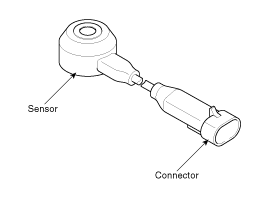Hyundai Tucson: Engine Control System / Knock Sensor (KS) Description and Operation
Hyundai Tucson (LM) 2010-2015 Service Manual / Engine Control / Fuel System / Engine Control System / Knock Sensor (KS) Description and Operation
| Description |
Knocking is a phenomenon characterized by undesirable
vibration and noise and can cause engine damage. Knock Sensor (KS) is
installed on the cylinder block and senses engine knocking.
When knocking occurs, the vibration from the cylinder block
is applied as pressure to the piezoelectric element. When a knock
occurs, the sensor produces voltage signal. The ECM retards the ignition
timing when knocking occurs. If the knocking disappears after retarding
the ignition timing, the ECM will advance the ignition timing. This
sequential control can improve engine power, torque and fuel economy.

 Camshaft Position Sensor (CMPS) Repair procedures
Camshaft Position Sensor (CMPS) Repair procedures
Inspection
1.
Check the signal waveform of the CMPS and CKPS using the GDS.
Specification: Refer to “Wave Form”
Removal
•
DON’T remove the camshaft pos ...
 Knock Sensor (KS) Specifications
Knock Sensor (KS) Specifications
Specification
ItemSpecificationCapacitance (pF)850 ~ 1,150
...
Other information:
Hyundai Tucson (LM) 2010-2015 Service Manual: CVVT Oil Control Valve (OCV) Specifications
Specification
ItemSpecificationCoil Resistance (x)9.4 ~ 10.4 [20°C(68°F)]
...
Hyundai Tucson (LM) 2010-2015 Service Manual: BJ Boot Repair procedures
Removal
1.
Remove the front driveshaft.
(Refer to Driveshaft Assembly - “Front Driveshaft”)
2.
Remove the TJ joint assembly.
(Refer to Driveshaft Assembly - “TJ Joint”)
3.
Remove the Dynamic damper.
(Refer to Driveshaft Assembly - “Dynamic Damper”)
4.
Using a plier ...
© 2010-2024 www.htmanual.net
